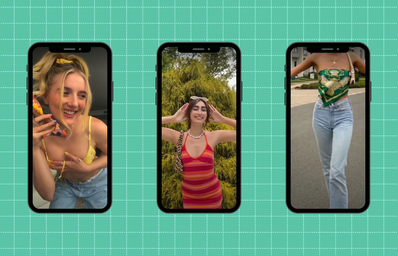During the past couple of years and through peak pandemic, TikTok has skyrocketed in popularity, particularly amongst Gen-Z. It’s now one of the most commonly used social media platforms, enticing users with uniquely generated feeds of short videos that are based on personal interests rather than following individual pages. Because of this setup, users can get thousands of views from people they have probably never interacted with before, which makes the platform a prime place for getting the word out there.
TikTok’s format, however, which is comprised of a never-ending feed of videos between 15 seconds and 3 minutes, has rapidly reduced our communal attention span and has given way to the immense acceleration of trend popularity. Because it is so easy to move on to the next best thing, popular trends change on a dime, most notably with fashion.
TikTok has revolutionized the fashion industry. Not only are there many influencers on the app that dictate popular fashion trends, but the app setup allows for even an “average” person (meaning not a celebrity or known “influencer”) to make an impact on what’s considered “in.” There are many common trends on the app that relate to fashion, namely, different outfits you wear in a week, try-on hauls from different clothing stores, “must-have” items, easy linking to Amazon pages, and even a new filter that dictates what “aesthetic” you should dress as that day.
However, because of how fast-moving the app is and how it allows for the quick rise to the popularity of many products, the fast fashion industry is booming — and bringing with it unsustainable manufacturing methods, exploitation of workers, and overproduction of products. The main brands that TikTok users buy are typical under the title of “fast-fashion”— cheap and on-trend clothing that is more accessible, but also typically doesn’t last and is known to be problematic due to its impacts on pollution, waste, and unethical working conditions. Fast fashion accounts for 10% of carbon emissions, uses up a lot of energy and resources to produce, and creates many chemicals and waste during production that eventually end up in landfills or the ocean.
Because new trends are born rapidly and so many people are engaging with the fashion crazes on TikTok, many clothes are being bought just to stay with the current trends or to do “hauls” for their channel, and many of these items are then discarded after the trend dissipates or get thrown away because of their cheaply-made quality. Thus, more clothes end up in landfills, which creates even more waste or releases microplastics. To compound the waste, high turnover rates in trends mean a lot of products are starting to go out of style by the time companies catch wind of them and begin production. Because of this, the garment age within a company faces severe reduction and ends up being thrown away at the end-of-cycle. In addition to being unsustainable, many fast fashion companies exploit their workers. This type of clothing production is done in factories, and workers face unfair wages, long and intense hours, and unsafe working conditions. Fast fashion is highly detrimental to the environment and to the workers that form the basis of the industry.
Fast fashion was a problem before TikTok, and the app is not causal of the adverse effects. However it has contributed to the rapid acceleration of production and exaggerated the negative impacts of fast fashion. Fast fashion, while harmful, has also made fashion a lot more accessible to people regardless of socioeconomic status. We’re all victims to following fashion trends; it’s a big part of being part of the “it” crowd. And this isn’t to say that one person has the power to solve all of the problems of fast fashion, but if we begin to utilize more sustainable fashion practices and advocate for garment workers’ rights, we can begin to make changes toward the impact that mass consumption can have on our Earth and each other. It’s okay to buy some trendy pieces, but try to aim for buying more timeless, staple pieces that will complement your wardrobe for years to come. Make sure you’re getting the most wear out of the pieces you buy. Promote more sustainable ways to engage in trends on TikTok. Small changes can have big impacts, so if we all work on trying to incorporate more sustainable fashion practices into our wardrobes, we can work to counteract the negative impacts of fast fashion propagated by TikTok.


